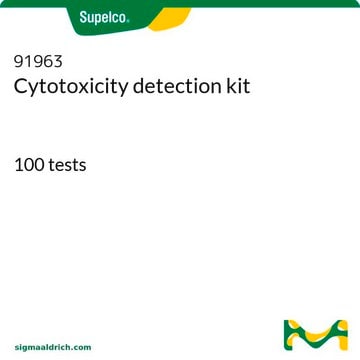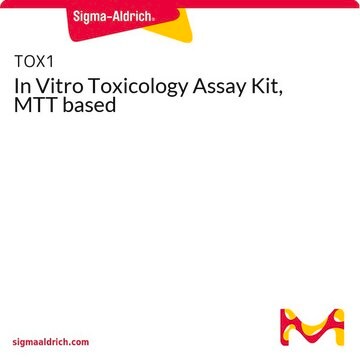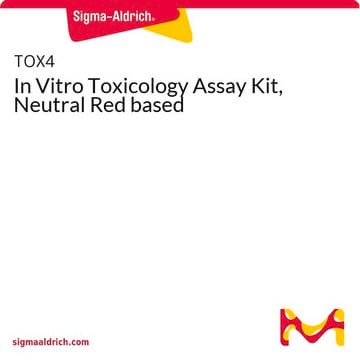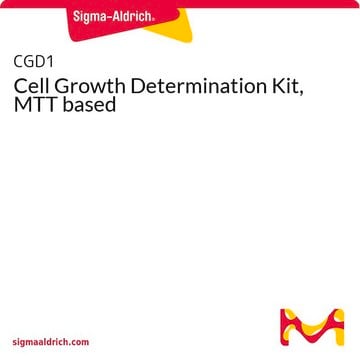11644793001
Roche
Cytotoxicity Detection Kit (LDH)
suitable for protein quantification, suitable for cell analysis, detection, sufficient for ≤2,000 tests
Synonim(y):
LDH
About This Item
Polecane produkty
zastosowanie
sufficient for ≤2,000 tests
Poziom jakości
opakowanie
pkg of 1 kit
producent / nazwa handlowa
Roche
metody
protein quantification: suitable
λmaks.
490 nm
Zastosowanie
cell analysis
detection
metoda wykrywania
colorimetric
temp. przechowywania
−20°C
Powiązane kategorie
Opis ogólny
Colorimetric assay for the quantification of cell death and cell lysis, based on the measurement of lactate dehydrogenase (LDH) activity released from the cytosol of damaged cells into the supernatant.
Zastosowanie
- Detection and quantification of cell-mediated cytotoxicity
- Determination of mediator-induced cytolysis
- Determination of the cytotoxic potential of compounds in environmental and medical research, and in the food, cosmetic, and pharmaceutical industries
- Determination of cell death in bioreactors
- Testing of biocompatibility of various scaffolds, employed in bone tissue engineering, for bone cell growth
Opakowanie
Uwaga dotycząca przygotowania
Reconstitute the lyophilisate in 1 ml double dist. water for 10 minutes and mix thoroughly.
Vial 2 Dye solution:
Ready-to-use solution.
Reaction mixture
For 100 tests: Shortly before use, mix 250 μl of vial 1 with 11.25 ml of vial 2.
For 400 tests: Shortly before use, add the total volume of catalyst (1 ml) to the total volume
of dye solution (45 ml) and mix well.
Note: The Reaction mixture should not be stored; prepare immediately before use.
Storage conditions (working solution): 2 to 8 °C
The lyophilizate is stable at 2 to 8 °C.
The reconstituted catalyst solution is stable for four weeks when stored at 2 to 8 °C.
Once thawed, the dye solution is stable for several weeks when stored at 2 to 8 °C.
Tylko elementy zestawu
- Catalyst (Diaphorase/NAD+ mixture)
- Dye Solution (INT and sodium lactate)
produkt powiązany
Hasło ostrzegawcze
Warning
Zwroty wskazujące rodzaj zagrożenia
Zwroty wskazujące środki ostrożności
Klasyfikacja zagrożeń
Eye Irrit. 2
Kod klasy składowania
12 - Non Combustible Liquids
Klasa zagrożenia wodnego (WGK)
WGK 1
Temperatura zapłonu (°F)
does not flash
Temperatura zapłonu (°C)
does not flash
Certyfikaty analizy (CoA)
Poszukaj Certyfikaty analizy (CoA), wpisując numer partii/serii produktów. Numery serii i partii można znaleźć na etykiecie produktu po słowach „seria” lub „partia”.
Masz już ten produkt?
Dokumenty związane z niedawno zakupionymi produktami zostały zamieszczone w Bibliotece dokumentów.
Klienci oglądali również te produkty
Produkty
Quality control guidelines to maintain high quality authenticated and contamination-free cell cultures. Free ECACC handbook download.
Powiązane treści
Cytotoxicity Detection Kit (LDH) Protocol & Troubleshooting
Zestaw do wykrywania cytotoksyczności (LDH) Protokół i rozwiązywanie problemów
Nasz zespół naukowców ma doświadczenie we wszystkich obszarach badań, w tym w naukach przyrodniczych, materiałoznawstwie, syntezie chemicznej, chromatografii, analityce i wielu innych dziedzinach.
Skontaktuj się z zespołem ds. pomocy technicznej













